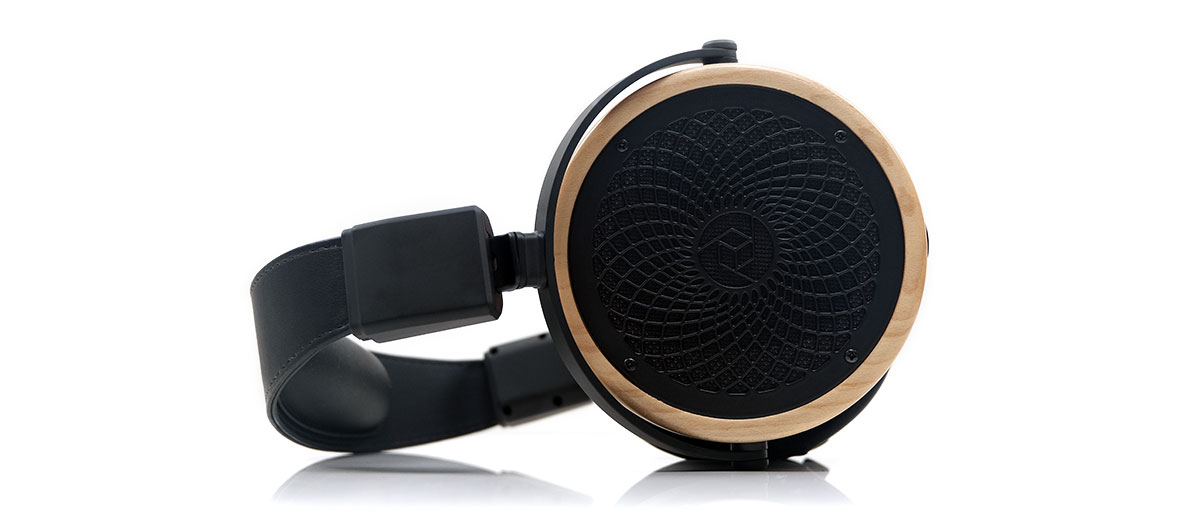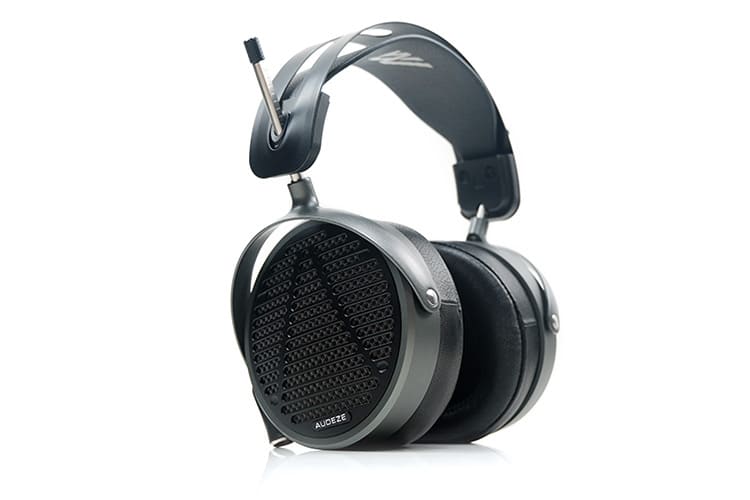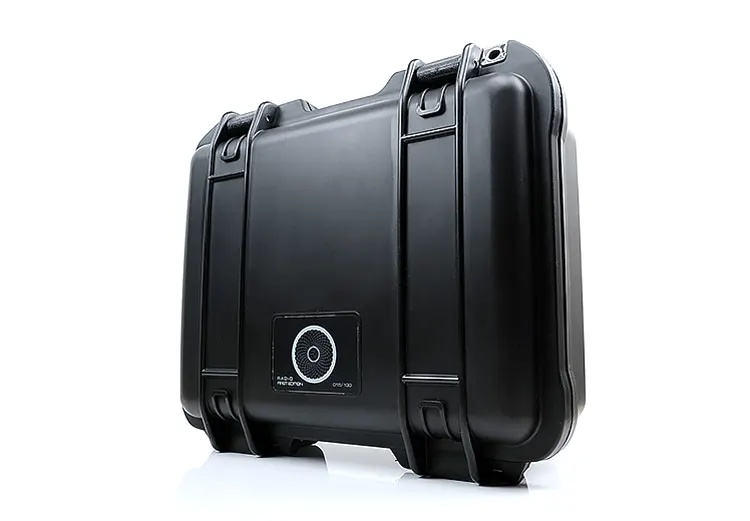Select Comparisons
The following comparisons were completed using a mix of the Cayin C9 with the N7 as its source, the Chord Electronics Qutest/Anni combo, and the two dedicated tube amplifiers, the Feliks Audio Envy, and the Cayin HA-300MK2 with a Holo Audio Spring 2 Wildism Edition DAC as their source.
Rosson Audio Design RAD-0
$2600
The Rosson Audio Design RAD-0 was the first headphone to be launched by the company back in 2019 and to this day is still their flagship offering. We also awarded it our Top Gear Awards Editor’s Choice in 2019. You can read our full review of the RAD-0 here.
Technical
As you have been reading there is a lot of tech overlap in these two headphones which does give the MPL-0 a very nice value-add in my books given the price gap.
Both are open-back circumaural planar magnetic driver headphones. They also share a similar-sized 66mm planar driver with a proprietary array of 11 N52 magnets in a dual-sided configuration. The impedance is the same at 29Ω and the sensitivity rating, (SPL), is the same weighting at 98dB @1kHz.
It would be a logical assumption that both headphones share the same driver with the MPL-0 version being re-tuned somewhat with the aid of the new pad design.
The numbers and assumption would seem to be also back-up in our real-world testing using the high-gain setting of the Cayin C9 with the N7 as our source on a line-in. Neither headphone sounded out of sync for volume and power. Save for any sensitivities to timbral differences the dynamics from both headphones were the same for me on this setup.
There is no change in the basic dual-entry connector system though I do have to note that the MPL-0 version does have an aluminum ring on the entry whereas the dyed molded RAD-0 cups do not have that. I presume then this is a stiffening exercise to prevent any cracks in the MPL-0 maple cups.
Design
This is where the bigger changes are, at least aesthetically. The RAD-0 uses a tie-dye process combined with a stabilized wood material to give each headphone and unique one-of-a-kind look and there are hundreds of looks to pick from. All are the same price also which, for me, is a great incentive to just go for what represents you.
The MPL-0 uses a stunning light-grain maple with a glossy finish. In truth, it does look like it could take a seat at the RAD-0 table if there was only ever one of them but there isn’t. This is the only design you get so be prepared to see every other MPL-0 owner out there have the same-looking headphones.
The design language, the mechanics, and the form factor have not changed save for the new ear pad designs on the MPL-0. Both headphones use a mix of aluminum and protein leather with a classic round cup and single headband form factor.
They are equally weighty, never the lightest in the market at around 550g but the MPL-0 deeper pads with a wider inner cavity do make them a little comfier to wear as well as shifting the pressure bias a bit more lateral and less vertical. I find the ear comfort has improved as a result.
The MPL-0 stock cable is a similar 22AWG OFC wire and nylon jacket finish but with a 1/4″ SE plug which is a better move than the original RAD-0 launched stock cable’s 3.5mm plug. I still think both should come with an XLR alternative though.
Performance
The stand-out differences between these two headphones are the mid-tuning and treble presence. In turn, the differences shape the harmonic balance of each headphone including the lows so you can consider it a knock-on effect.
Both the MPL-0 and RAD-0 have a similar bass FR being linear, flat, and well extended, but from about 1-4k the dip in the MPL-0 is more sudden and more noticeable. The RAD-0 1-3k is a gentler slope so it retains more energy through the same region and images comparatively further forward.
On the highs, the MPL-0 has a smoother sound and less energy through the 5-6k marker whereas the RAD-0 is more pronounced. It also lacks the same dip around 7-8k though both extend quite well.
Reducing the mids energy and treble presence will allow the MPL-0 even-harmonic presence to dominate a bit more with the net effect being a more rounded, warmer, and slightly softer tone throughout.
The RAD-0 has a bit more sizzle, especially through the mids but that stronger upper harmonic order will also help shine a light on lower pitching guitar plucks and kick drums sounding a little cleaner, perhaps cooler in tone, but more defined to my ear.
Imaging changes a lot for me with that midrange FR change on the MPL-0 pushing the perceived vocal and midrange instrumental imaging further back. The percussion timbre is more natural to my ear but like the vocal imaging, it falls back a bit placing the macro image of the MPL-0 more out in front of you and leading from the lows.
The RAD-0 pulls the staging up closer for me, with a more forward vocal image but also a bit more clarity and space that is especially noticeable for alternative rock voicing and higher pitching percussion presence.
Audeze MM-500
$1699
The Audeze x Manny Marroquin MM-500 was launched in the middle of last year and has been one of my go-to headphones for both listening and referencing for a while now. You can read our full review of the MM-500 here.
Technical
Like the MPL-0, the MM-500 is also an open-back circumaural planar magnetic headphone with a classic circular cup and single band structure.
Inside, the MM-500 driver size is a little larger at 90mm compared to the MPL-0 at 66mm. The MM-500 also uses a mix of LCD-5’s more efficient and lower impedance single-sided Fluxor™ magnet array, (14 magnets in total as opposed to 11) and Audeze’s Ultra-Thin Uniforce™ diaphragm technology.
And indeed, on paper, the MM-500 would seem to be the more efficient of the two headphones with an 18Ω impedance level and a moderate to easy 100dB SPL sensitivity rating compared to the 29Ω and 98dB equivalent from the MPL-0.
These numbers do stand up to qualitative scrutiny also using our C9/N7 combo with the MM-500 a fair bit more sensitive compared to the MPL at similar volumes using a high gain line-in and balanced PO output setting.
Design
Given the legacy of the two owners of Audeze and Rosson Audio Design, it should be no surprise that both headphones share a little slice of that commonality or shared thinking. That being said, the MPL-0 is definitely more ‘classic LCD-2’ whereas the MM-500 represents the recent design shift from Audeze that started with the LCD-5.
That means the MM-500 is a bit smaller than the MPL-0, possibly with fewer articulating components similar to the LCD-5 in an effort to reduce the weight. Indeed, that has worked as the MM-500 comes in at 495g compared to the MPL-0 at 550g and you can feel that difference in your hand and on your head.
In terms of comfort though, I would say it’s more even than you might think despite the weight difference. They are both heavy headphones with aluminum shells and headband structures but the clamping factor on the MM-500 is a bit stronger.
The MM-500’s deep and very plush protein leather pads seem to manage the clamping pressure a bit better and they also have wider inner cavity openings to give the ears more room to breathe.
Aesthetically, I have to give credit to Audeze for a very modern slick-looking headphone design. It’s minimalistic, and urban in a way and I hope they continue with this design philosophy. The MPL-0 is more boutique in its appearance but if you love wood then the maple design is beautiful and very eye-catching.
Both come with SE-terminated cables with the MM-500 using mini-XLR and a 1/4″ jack and the MPL-0 using 3.5mm connectors and the same plug. Both use copper wiring but the MM-500 version is a wider gauge at 20AWG compared to 22AWG. In theory, the resistance will be a bit lower on the MM-500 cable.
Performance
These two headphones are almost polar opposites in terms of tuning emphasis. The MM-500 is mids-forward with a rising curve from almost 500Hz up to 3k pushing out vocals, and higher-pitching percussion energy whilst keeping the bass tight and the treble south of the Harman from 5k onwards that successfully avoids sibilance.
The tonal coloration on the MPL-0 is smoother, sounding a little softer on the leading edges whereas the MM-500 is more neutral in its tone. However, by Audeze standards or compared to the LCD-5 I would call it natural-to-neutral in its coloration.
The MPL-0 is more extended and fuller-sounding sub-80Hz, and in the highs, it’s a gently rising curve from 5-10k offering a little more headroom and presence. However, right around 1-4k, where the MM-500 shows the strongest elevation, the MPL-0 shows its biggest dip.
That blunts the MPL-0 mids’ energy and loses the focus a little compared to the MM-500 so vocals will image further back. However, the user will perceive a wider or larger staging dimension from the MPL-0 with enhanced width and depth.
On the macro level, the MPL-0 simply sounds bigger and more spacious, but on the micro level, the MM-500 has more energy and clarity through the mids. If you want vocals up close and a punchier mix the MM-500 is a better choice but too much and it might fatigue whereas the MPL-0 is much gentler but lacks comparative vocal presence.
Just a final note on amping choices. I found the Cayin HA-300MK2 to do a lot more with the bigger staging quality of the MPL-0, whereas the MM-500 improved its depth and power with the better bass fundamental from the Feliks Audio Envy.
HIFIMAN Arya Stealth Magnet Edition
$1599
The HIFIMAN Arya Stealth Magnet Edition debuted in early 2022 is the first true revision of the original Arya that was launched in 2019. You can read our full review of the Arya Stealth Magnet Edition here.
Technical
Both the MPL-0 and the Arya are open-back circumaural planar magnetic headphones. However not much is known about the precise make-up of the 66mm driver inside the MPL-0 aside from it using a proprietary dual-sided array of 11 N52 neodymium magnets. The Arya is bolder with the name itself indicating what is happening inside.
There are 3 key areas of the driver inside the Arya including the introduction of the new stealth magnet system that has been gradually rolling out across the entire headphone line-up, the nanometer level of thickness NEO “superman” diaphragm, (NsD), and the window shade grill system to combat second reflections.
The HIFIMAN Araya Stealth Magnet Edition is rated at 32Ω and 94dB SPL @1kHz and with a relatively minor shift downwards in impedance at 29Ω, the MPL-0’s 98dB SPL rating on the equivalent weighting would make it the more efficient headphone on paper.
Indeed, once again on our C9/N7 rig with around 2.6W at 32Ω, almost precisely what both the MPL-0 and Arya will get, the Arya does sound a little softer using a matched volume in high gain mode but the gap was not as huge as I was expecting. It will not take too much tweaking to bring the Arya up to the same level as the MPL-0.
Design
Very different design languages and ultimately which you prefer, at least visually, will come down to what is a priority for you on a personal level.
If it comes down to weight and comfort on the head then it’s the Arya all day long. At 404g compared to 550g, you will feel that difference on the head right away. The Arya is far more comfortable, with a nice pressure balance and looser clamping. That would be my choice if you need headphones on your head 24/7.
If it is about durability, the MPL-0 is the better choice. It feels much more solid compared to the mix of plastic and steel on the HIFIMAN. Though by no means a poor build quality, it is less likely to survive a drop or from mishandling than the MPL-0.
Aesthetics has pros and cons for both. The MPL-0 has more visual pop with its glossy maple finish and classic round cup design giving it a classic boutique vibe. The Arya takes after its name, it’s all black, and stealthier with that legacy ovoid cup design first seen on the likes of the HE1000.
One final note, the cables that come with both headphones fit each other, as in the same dual entry 3.5mm connector system. If you happen to rock some balanced HIFIMAN cables with 3.5mm connectors they will fit perfectly fine with the MPL-0.
Performance
On a technical level, the Arya Stealth Magnet Edition has the faster driver sounding more articulate, and perhaps more resolving also but with some additional treble presence, this can often give you that perception of more detail.
On a tonal level, the MPL-0 is smoother, more forgiving, and more natural in its delivery. That dip in the mids and more relaxed treble combined give vocals a warmer tone, with better saturation and texture. It also has a better sub-bass presence firming up note weight and power.
The Arya is more ethereal, taller in its sound stage with more sparkle and mid-bass punch, but also with a stronger 2-5k rise.
It can sound clean and precise but also leaner in the mids, lacking in weight or the same bass fundamental as the MPL-0. So, vocals can sound a little dry, more sibilant-prone, and lacking in comparative levels of note body.
Now, I have tested the Arya on quite a few portable rigs and it runs just ‘ok’, polite if you will. However, you do miss that stronger bass dimension from the Stealth Edition tuning and it does come back 10-fold the more quality power you feed it. It’s not to the MPL-0 level but it’s certainly an upgrade on the original Arya.
So, if your initial A/B comparison of the Arya Stealth and the MPL-0 seems to give a lot of advantages to the MPL-0 bass response then double-check if you are feeding the Arya enough power to drive its less efficient driver properly.
Our Verdict
The Rosson Audio Design MPL-0 is a beautifully designed headphone and one which delivers a fulsome, smoother more relaxed sound signature compared to its flagship sibling, the RAD-0.
The two complement each other quite well with the RAD-0 offering a more intimate more energetic sound signature that I find works a charm with my aggressive mosh pit collection and the MPL-0 loosening the reins a bit more lending itself to some great performances with EDM and synthwave genres.
This is an easy-to-drive headphone so it will work well with both portable and desktop setups but will also respond to any amplifier’s own inherent sound characteristics so there is some flexibility there.
My own personal recommendation for the MPL-0 is to go clean, punchy, or something that generally helps tease out space and clarity in the mids. Once you get there you start to understand what Alex and the team at Rosson Audio Design are aiming for with the MPL-0.
Rosson Audio Design MPL-0
- Style: Over-ear, open-back, circumaural design
- Transducers: 66mm planar magnetic
- Frequency response: 20hz – beyond audible range
- Earpads: Oversized sustainable leather-free with soft fabric inner face
- Cable: 8’ 1/4in cable
- THD : <0.1%
- Impedance: 29Ω
- Weight: 550-615g dependent on materials and finish
- Case: Pelican style hard shell case with Eva foam insert with additional space for accessories





